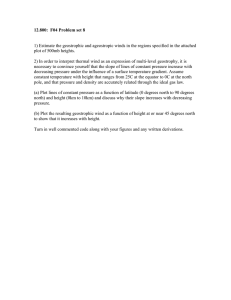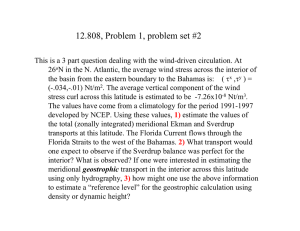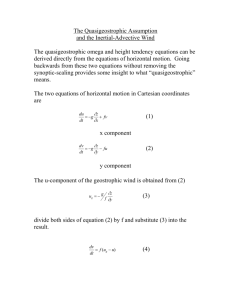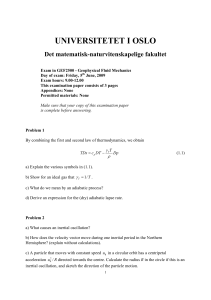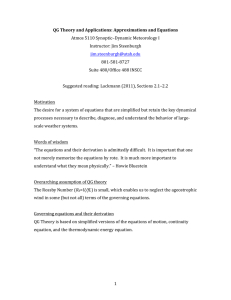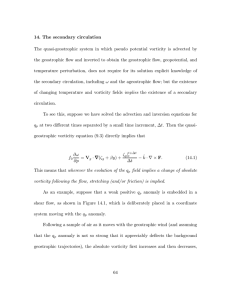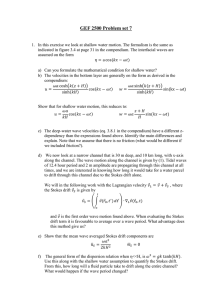5 Shallow water Q
advertisement
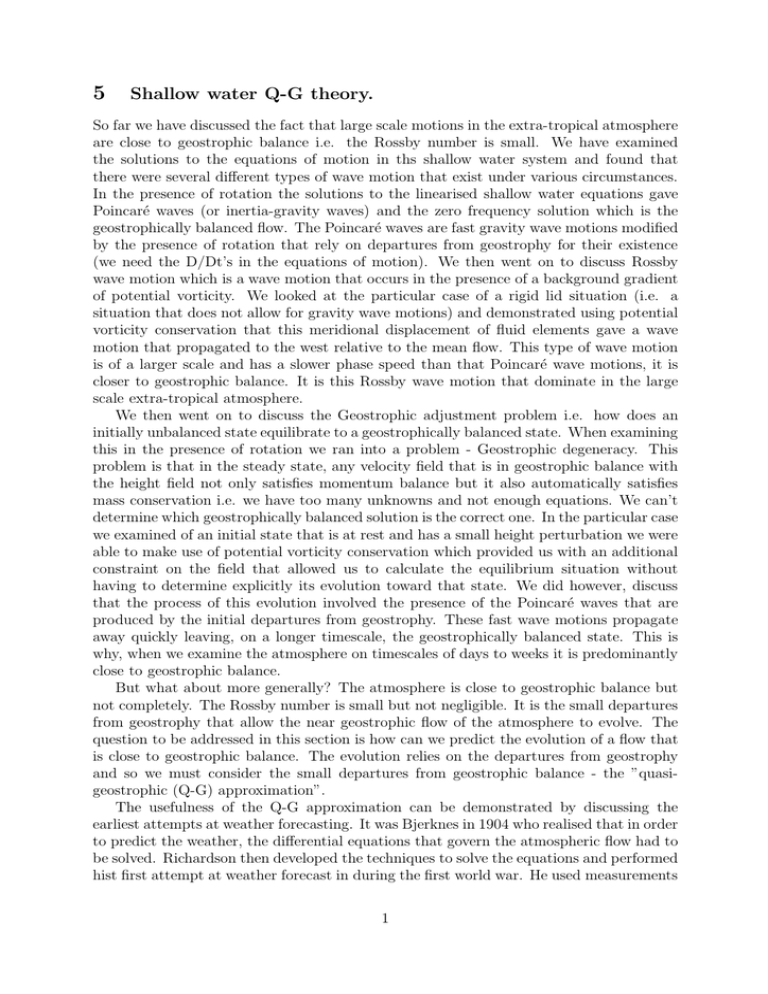
5 Shallow water Q-G theory. So far we have discussed the fact that large scale motions in the extra-tropical atmosphere are close to geostrophic balance i.e. the Rossby number is small. We have examined the solutions to the equations of motion in ths shallow water system and found that there were several different types of wave motion that exist under various circumstances. In the presence of rotation the solutions to the linearised shallow water equations gave Poincaré waves (or inertia-gravity waves) and the zero frequency solution which is the geostrophically balanced flow. The Poincaré waves are fast gravity wave motions modified by the presence of rotation that rely on departures from geostrophy for their existence (we need the D/Dt’s in the equations of motion). We then went on to discuss Rossby wave motion which is a wave motion that occurs in the presence of a background gradient of potential vorticity. We looked at the particular case of a rigid lid situation (i.e. a situation that does not allow for gravity wave motions) and demonstrated using potential vorticity conservation that this meridional displacement of fluid elements gave a wave motion that propagated to the west relative to the mean flow. This type of wave motion is of a larger scale and has a slower phase speed than that Poincaré wave motions, it is closer to geostrophic balance. It is this Rossby wave motion that dominate in the large scale extra-tropical atmosphere. We then went on to discuss the Geostrophic adjustment problem i.e. how does an initially unbalanced state equilibrate to a geostrophically balanced state. When examining this in the presence of rotation we ran into a problem - Geostrophic degeneracy. This problem is that in the steady state, any velocity field that is in geostrophic balance with the height field not only satisfies momentum balance but it also automatically satisfies mass conservation i.e. we have too many unknowns and not enough equations. We can’t determine which geostrophically balanced solution is the correct one. In the particular case we examined of an initial state that is at rest and has a small height perturbation we were able to make use of potential vorticity conservation which provided us with an additional constraint on the field that allowed us to calculate the equilibrium situation without having to determine explicitly its evolution toward that state. We did however, discuss that the process of this evolution involved the presence of the Poincaré waves that are produced by the initial departures from geostrophy. These fast wave motions propagate away quickly leaving, on a longer timescale, the geostrophically balanced state. This is why, when we examine the atmosphere on timescales of days to weeks it is predominantly close to geostrophic balance. But what about more generally? The atmosphere is close to geostrophic balance but not completely. The Rossby number is small but not negligible. It is the small departures from geostrophy that allow the near geostrophic flow of the atmosphere to evolve. The question to be addressed in this section is how can we predict the evolution of a flow that is close to geostrophic balance. The evolution relies on the departures from geostrophy and so we must consider the small departures from geostrophic balance - the ”quasigeostrophic (Q-G) approximation”. The usefulness of the Q-G approximation can be demonstrated by discussing the earliest attempts at weather forecasting. It was Bjerknes in 1904 who realised that in order to predict the weather, the differential equations that govern the atmospheric flow had to be solved. Richardson then developed the techniques to solve the equations and performed hist first attempt at weather forecast in during the first world war. He used measurements 1 Pressure (hPa) 1080 1060 1040 1020 1000 0 5 10 Time (hours) 15 20 Figure 1: An idealised example of surface pressure fluctuations that may be observed over a day (dotted) and the pressure fluctuations that would be associated with the slower near geostrophic flow (i.e. the evolution minus the higher frequency noise associated with inertia-gravity type motions) (solid). from 7am on 20th May 1910 and attempted to predict atmospheric conditions at a single point 6 hours later that could then be compared with the observations made at that time. This calculation took 6 weeks to complete and gave a surface pressure variation over the 6 hours of 145hPa which was over 100 times greater than the surface pressure fluctuation that was actually observed. The problem was that the calculation didn’t take into account the small scale fluctuations (noise) in the system associated with the short timescale ageostrophic inertia-gravity motions. Consider Fig. 1 which shows an idealised example of typical variations in surface pressure over a day. What we see here are short timescale fluctuations associated with inertia-gravity wave type motions (dotted). But, this is on top of a longer timescale background evolution (solid). This longer timescale background evolution is the evolution of the large scale near geostrophic flow i.e. the motion that is really of interest for determining weather conditions on the timescale of hours to days. This figure illustrates the problem associated with the presence of the high frequency noise in the system. You could measure a rate of change of pressure or a velocity field at particular point in time but a large component of that measurement could be associated with the noise rather than the slower evolving flow that we are interested in. The quasi-geostrophic approximation developed by Charney in 1947 is an approximation to the full equations of motion that effectively filters out the noise and produces a single predictive equation for the time evolution of the geostrophic flow taking into consideration the small departures from geostrophy. This development together with the development of computers allowed for the first successful weather forecast in 1950. Now, computing power has increased so much that numerical weather forecasting models can actually solve the full equations of motion. However, the Q-G approximation still remains 2 important in the initialisation of weather forecasts - it is important not to initialise them with the high frequency noise. 5.1 Assumptions of the Q-G Approximation There are four main assumptions that are made when formulating the Q-G approximation. These are • (1) The Rossby number is small (Ro = U/f L) i.e. it is nearly in geostrophic balance. The ageostrophic velocities (~va ) are small compared to the geostrophic velocities i.e. ~va ∼ O(Ro) ~vg • (2) The scale of the motion is not significantly larger than the deformation radius 2 L ∼ O(1) L2D √ where LD = gH/f . This ratio, L2 /L2D , is 1/Bu where Bu is the Burger number. It will be shown that this is equivalent to stating that the variations in the fluid depth are small compared to its total depth. • (3) Variations in the coriolis parameter are small βL ∼ O(Ro ) fo f = fo + βy So, the variations in the coriolis parameter over the horizontal length scale L are small compared to the coriolis parameter itself. Note that this is not a good approximation in the tropics. • (4) The timescale that we are considering is the advective timescale. Since the geostrophic velocities are much larger than the ageostrophic velocities, the advection over this timescale is by the geostrophic velocities such that ∂ ∂ ∂ D = + ug + vg Dt ∂t ∂x ∂y 5.2 Q-G momentum balance The full shallow water momentum balance is given by D~vH + f × ~vH = −g∇h Dt (1) Consider the velocity field to be made up of a geostrophic and an ageostrophic component such that ~va ~v = ~vg + ~va where ∼ O(Ro) ~vg 3 Consider characteristic length (L), velocity (U) and timescales (T ) of the motion and a typical scale of height perturbation (∆H). If we were to consider only the order 1 terms of Eq 1 we could just have geostrophic balance f × ~vg = −g∇h. (2) This allows us to determine the characteristic scale of height perturbations ∆H. Scale analysis of this equation gives f × ~vg = −g∇h ∆H fU g L So, the right hand side term scales as f U and this allows us to also demonstrate that the assumption of L2 /L2D ∼ 1 is equivalent to stating that height perturbations are small compared to the mean layer depth. ∆H ∼ f UL g This can be rearranged making use of the definition of the Rossby number and the Rossby radius of deformation to give L2 ∆H ∼ Ro H 2 LD Given that we are considering L2 /L2D ∼ 1 means that ∆H/H ∼ Ro . Since the Rossby number is small this implies that variations in the free surface height are small compared to the mean layer depth. Now re-writing (1) using ~v = ~vg + ~va and f = fo + βy and performing a scale analysis gives D~vg D~va + +(f × ~vg ) + (f Dt Dt U Ua fU T T UUa U2 fU L L U Ua 1 fL fL Ro Ro2 1 × ~va ) +(βy × ~vg ) + (βy × ~va ) = −g∇h f Ua βLU βLUa fU f Ua βLU βLUa fU Ua U Ro βL f Ro βL Ua f U Ro2 1 1 It can be seen that the terms of order 1 represent geostrophic balance as expected. By definition of the geostrophic velocity the terms of order 1 exactly balance. Considering then the terms of order Ro and neglecting the higher order terms gives the Q-G momentum balance as D~vg (3) + (fo × ~va ) + (βy × ~vg ) = 0 Dt So, to zeroth order there is geostrophic balance. When considering departures from geostrophy but only retaining terms that are of the order of the Rossby number and neglecting higher order terms there is acceleration of the geostrophic flow by the coriolis force acting on the ageostrophic velocity and the variation of the coriolis force with latitude on the geostrophic velocity. 4 5.3 Q-G Mass Continuity The full shallow water mass continuity equation is given by Dh + h(∇~vH ) = 0 Dt (4) Remember the scaling for ∆H (∆H ∼ Ro HL2 /L2D ) and consider the height field to consist of a mean layer depth and a perturbation h ∼ H + ∆H where the time and spatial derivatives of the mean layer depth are zero. The mass continuity equation can be re-written and scaling analysis performed to give D∆H + H(∇.~vg ) +H(∇.~va ) + ∆H(∇.~vg ) +∆H(∇.~va ) = 0 Dt HU HUa ∆HU ∆HUa ∆H T L L L L ∆HU HU HUa ∆HU ∆HUa L L L L 2 L 2 2 U HU HUa L U L Ua L Ro H Ro H Ro H 2 2 2 LD L L L LD L L U 2 2 D2 Ua L L L Ua Ro 1 Ro Ro 2 2 2 LD U LD LD U Ro 1 Ro Ro Ro2 0 0 0 0 0 So, to order (1) we have ∇.~vg = 0 i.e. the divergence of the geostrophic velocity is zero. This comes from the definition of the geostrophic velocity on an f plane for an incompressible fluid where ug = −(g/f )∂h/∂y and vg = (g/f )∂h/∂x. Taking the divergence of this clearly gives you zero. To higher order (neglecting the fourth term which is also by definition 0) we are left with the terms of order Ro as follows Dh (5) + H(∇.~va ) = 0 Dt This is the Q-G shallow water mass conservation equation. It states that changes in the free surface height are determined by the divergence of the ageostrophic velocity. This makes sense given that the geostrophic velocity is non-divergent so it doesn’t contribute to a change in the free surface height. 5.4 The Q-G PV Equation The shallow water momentum and mass conservation equations are D~vg + (f ~k × ~va ) + (βy~k × ~vg ) = 0 Dt (6) Dh + H(∇.~va ) = 0 (7) Dt where D/Dt = ∂/∂t + ug ∂/∂x + vg ∂/∂y. But, this isn’t a closed system of equations. We have equations for the rate of change of geostrophic quantities but they’re interms of 5 ageostrophic quantities, which we don’t have an equation for. We can obtain an equation for the time rate of change of geostrophic quantities in terms of geostrophic quantities themselves by forming the Q-G PV equation. Equation 6 can be re-written using the following vector identity 1 (~vg .∇)~vg = ∇(~vg .~vg ) − ~vg × (∇ × ~vg ) 2 to give ∂~vg 1 + ∇(~vg .~vg ) + (ζ~ × ~vg ) + (fo~k × ~va ) + (βy~k × ~vg ) = 0 ∂t 2 The vorticity equation can then be formed by taking the curl of this ∂ ζ~ + ∇ × (ζ~ × ~vg ) + ∇ × (fo~k × ~va ) + ∇ × (βy~k × ~vg ) = 0 ∂t Then making use of the vector identity ~ × B) ~ = A(∇. ~ ~ − B(∇. ~ ~ + (B.∇) ~ ~ − (A.∇) ~ ~ ∇ × (A B) A) A B each of the cross products can be re-written and a large number of terms are zero to give ∂ ζ~ + (~vg .∇)ζ~ + fo (∇.~va ) + β~vg = 0 ∂t Note that since the divergence of the geostrophic velocity is zero and we are considering an incompressible fluid then ∇.~va = ∂wa /∂z. So, the term involving the divergence of the ageostrophic velocity represents vortex stretching. So, this equation relates the rate of change of vorticity to the advection of vorticity, the advection of planetary vorticity and vortex stretching. We can make use of the continuity equation (7 to replace the divergence of the ageostrophic velocity ∂ ζ~ 1 Dh ~ + β~vg = 0 + ~vg .∇)ζ + fo − ∂t H Dt Making use of the fact that D(βy)/Dt = βvg and then grouping up the material derivatives gives D ~ fo ζ + βy − h = 0 Dt H Thus we have shallow water potential vorticity conservation of the form Dq =0 Dt q = ζ + βy − fo h H (8) This can be written in terms of the perturbation height field recalling that ug = − fgo ∂h ∂y ′ and vg = fgo ∂h to give ∂x ′ Dq =0 Dt q= 6 fo g 2 ′ ∇ h + βy − h′ fo H (9) Or, it can be written in terms of the geostrophic stream function ψg = gh′ /fo giving Dq =0 Dt q = ∇2 ψg + βy − 1 ψg L2D (10) We therefore have a single predictive equation for the height field or stream function from which we can obtain the geostrophic velocity field. Equation 8 or 9 can be used to find the time evolution of the geostrophic flow. If you know the potential vorticity at an initial time t and you can invert the PV operator to find the geostrophic velocities then you can use those geostrophic velocities to advect the PV to find out the PV at a later time t + ∆t as a function of x and y (provided you can neglect boundary effects and diabatic heating) e.g. Dq ∂q ∂q ∂q =0→ = −ug − vg Dt ∂t ∂x ∂y The PV at time t + ∆t could be calculated by ∂q q(t + ∆t) = q(t) + ∆t ∂t t From this new distribution of PV the geostrophic velocities can be found and so on. The Q-G PV given by Eq. 5.4 can be compared with the full shallow water PV Dq =0 Dt q= f +ζ h It can be seen that if, in this full PV, you consider the height field to consist of a mean depth plus a perturbation and you linearise and ignore second order terms in Rossby number then you would obtain the Q-G PV. In sections 4.2.1-4.2.4 we solved the full linearised Q-G equations where we assumed that the height and velocity perturbations were small but we didn’t make any assumptions about being close to geostrophic balance. That gave several different types of wave solutions: Inertia-gravity waves, Kelvin waves and Rossby waves. For Inertia-gravity waves we combined the momentum equations on an f -plane to give 2 ∂ ∂ 2 2 2 (11) + fo − c ∇ h′ = 0 2 ∂t ∂t This equation has three time derivatives and gave us three solutions, the zero frequency flow that is in geostrophic balance and the dispersive inertia-gravity waves of positive and negative frequencies. For Rossby waves, we allowed there to be a variation in the background potential vorticity and solved the PV equation which had a rigid lid (i.e. we didn’t allow there to be gravity wave motion). This gave us ′ ∂(∇2 ψ ′ ) ∂ψ ∂ 2 ′ (12) (∇ ψ ) + U +β ∂t ∂x ∂x Now, in the Q-G approximation the equation to solve is 9. The similarity between this and Eq. 11 is apparent. In the Q-G equation there is only one time derivative (not three as in Eq. 10) so there’s only one frequency per wavenumber. In the Q-G PV equation, 7 the only solution we’re left with is the Rossby wave solution. Inertial-gravity waves are no longer solutions to the equations. The Rossby wave motion is the motion that satisties our initial assumptions (1) to (4). By making those assumptions and modifying the equations accordingly we have effectively filtered out the faster inertia-gravity wave motion. We are left with a prognostic equation for the evolution of the near geostrophic flow in terms of geostrophic quantities. It is this reduction of the equations of motion to a single equation which filters out the high frequency noise that allowed for the first successful weather forecasts. 8
